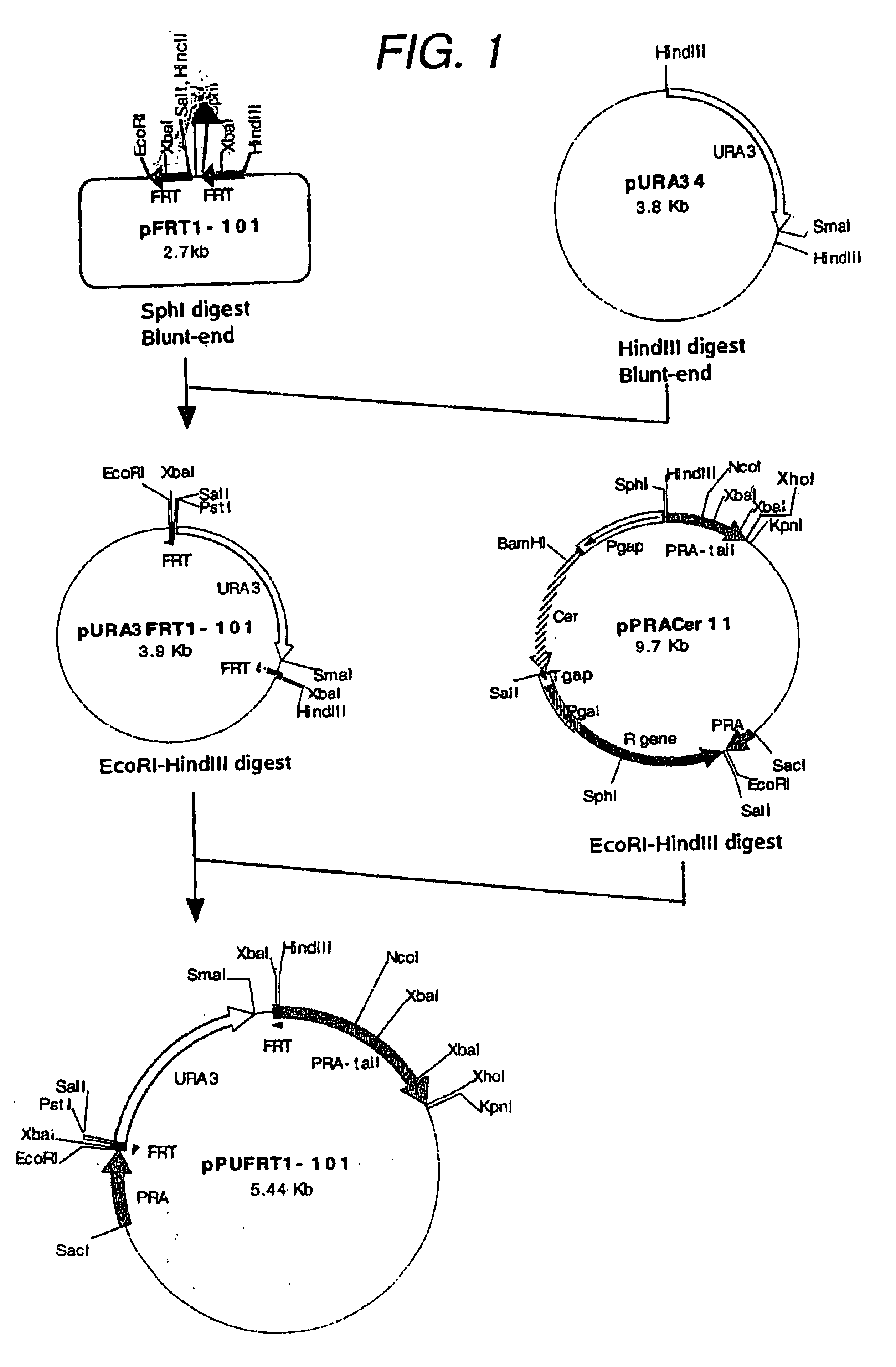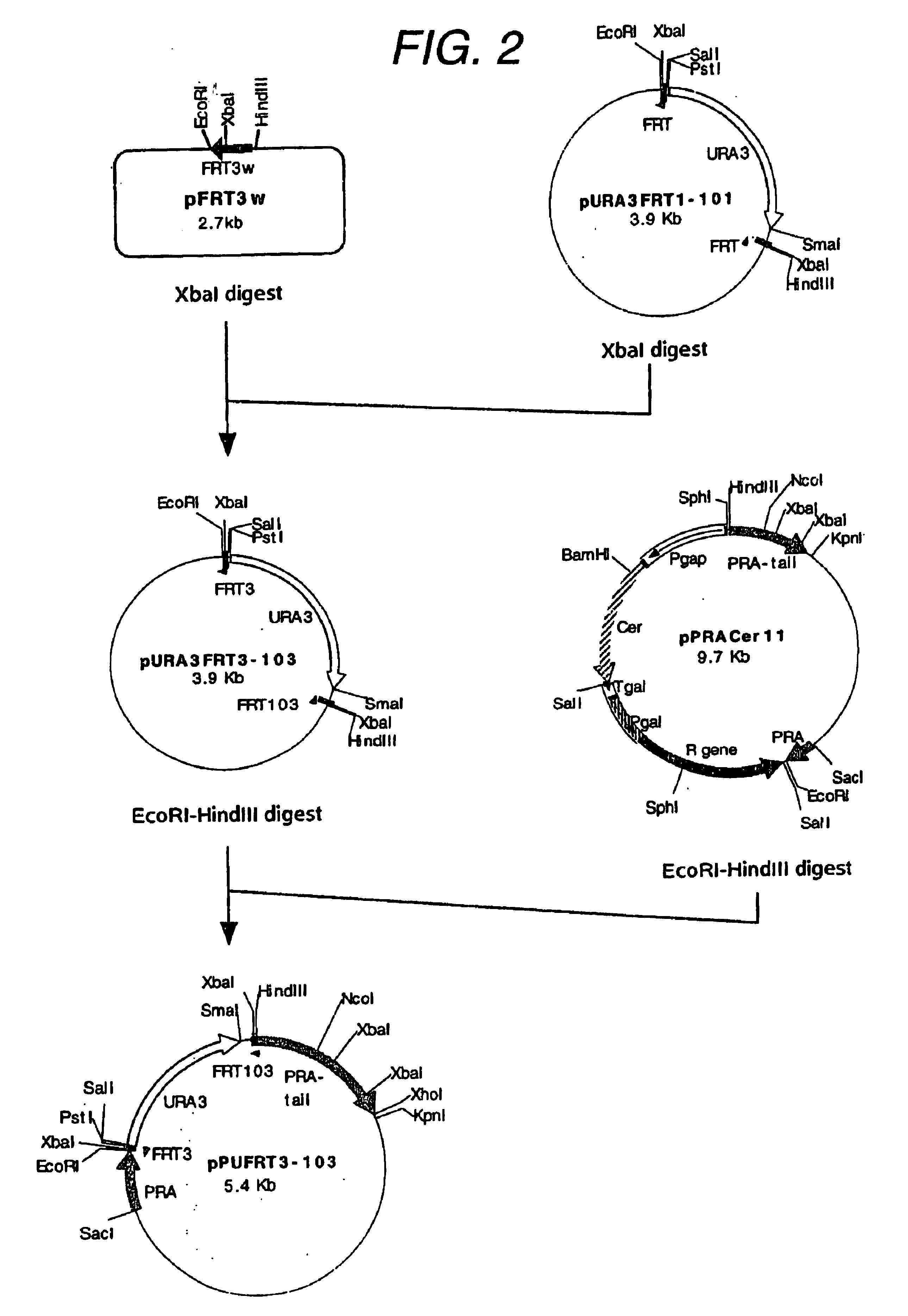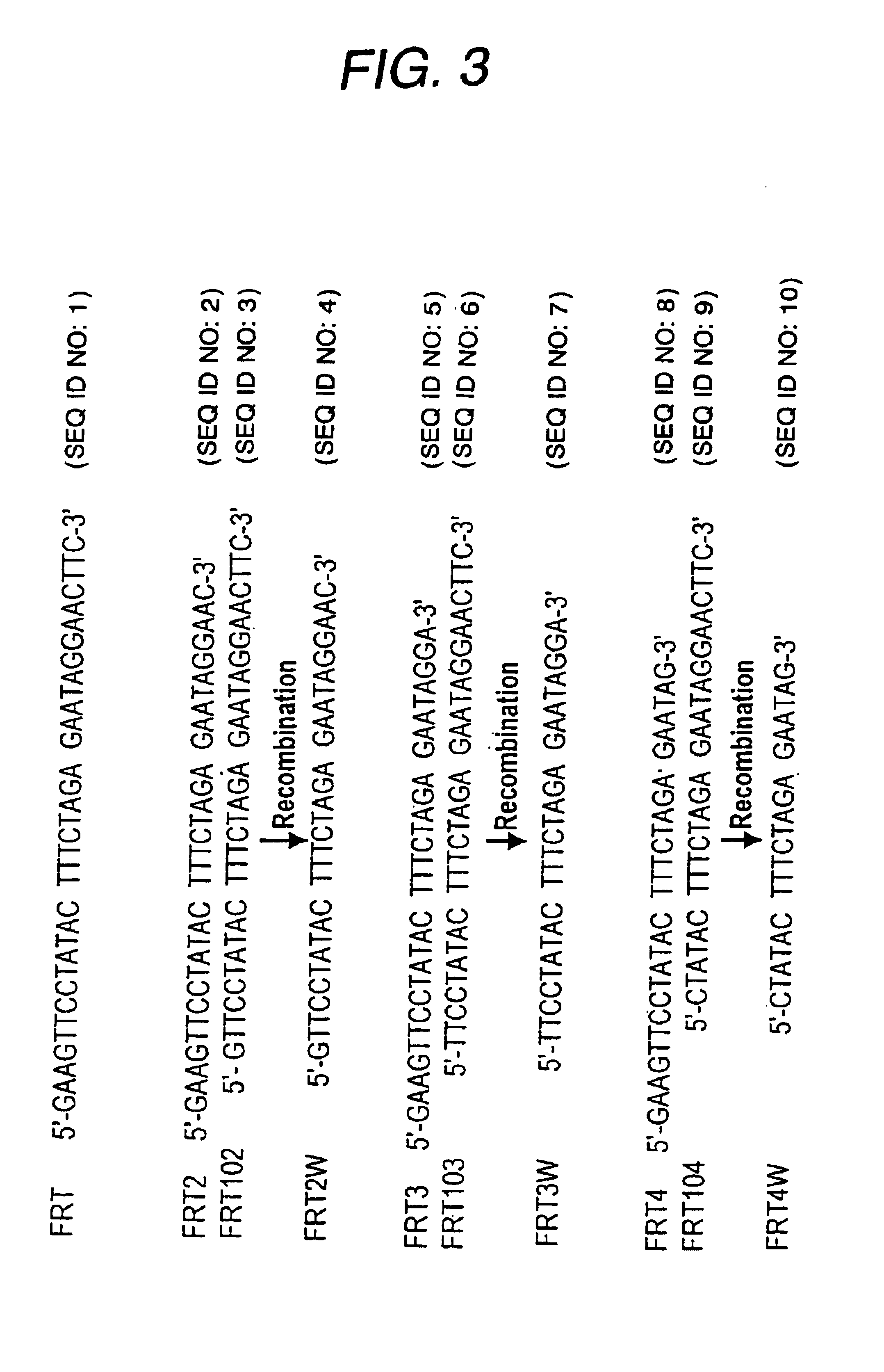DNA construct for transforming a yeast
a yeast and dna technology, applied in the field of dna constructs for transforming yeasts, can solve the problems of low gene transfer efficiency, 34-bp frt sequences are not suitable for commercial use, undesired recombination,
- Summary
- Abstract
- Description
- Claims
- Application Information
AI Technical Summary
Benefits of technology
Problems solved by technology
Method used
Image
Examples
example 1
Study of Excision Efficiency of a Selective Marker Gene Using FRT Sequences
(1) Construction of a Plasmid Containing Wild-type FRT Sequences
The following 4 oligonucleotides were synthesized to insert FRT sequences into the plasmid (with wild-type FRT sequences underlined).
FRT1-a
5'-TCGACGAAGTTCCTATACTTTCTAGAGAATAGGAACTTCG-3' (SEQ ID NO: 11)
FRT1-b
5'-AATTCGAAGTTCCTATTCTCTAGAAGTATAGGAACTTCG-3' (SEQ ID NO: 12)
FRT101-a
5'-AGCTTGAAGTTCCTATACTTTCTAGAGAATAGGAACTTCGCATG-3' (SEQ ID NO: 13)
FRT101-b
5'-CGAAGTCCTATTCTCTAGAAAGTATAGGAACTTCA-3' (SEQ ID NO: 14).
After phosphorylation of the ends of these synthetic DNAs, FRT1-a was annealed to FRT1-b and FRT101-a was annealed to FRT101-b, and the former annealed product was inserted at a restriction endonuclease EcoRI-SalI site and then the latter annealed product was inserted at a restriction endonuclease SphI-HindIII site of pUC18 (Toyobo) to construct a plasmid pFRTI-101 (FIG. 1).
The selective marker gene used was the URA3 gene. Strains bearing the URA...
example 2
Study of Excision Efficiency of a Selective Marker Gene Using a Combination of FRT Sequences and GIN11
(1) Construction of Plasmid pPUGINFERT3-103
Two oligonucleotides were synthesized to prepare a plasmid containing GIN11.
GIN-1: 5'-TGGATCCGGAATTTCGACGGATCAATAAC-3' (SEQ ID NO: 27)
GIN-2: 5'-TTCTGCAGACTAGATGCACTCATATCATTATGCAC-3' (SEQ ID NO: 28).
A fragment of about 0.7 kb obtained by PCR on plasmid pAUR135 (Takara Shuzo) as a template using these oligonucleotides as primers was treated with BamHI and PstI, and inserted at an EcoRI-PstI site of pUC19 together with a fragment of about 0.8 kb containing the GAL1 promoter obtained by treating pRM999 (JPA 66587 / 98) with EcoRI and BamHI to construct a plasmid pPGAL1GIN (FIG. 4) containing GIN11M86 (Takara Shuzo) linked to the GAL1 promoter.
A fragment of about 1.5 kb obtained by treating said plasmid with EcoRI and PstI was blunt-ended with Blunting Kit (Takara Shuzo) and then inserted at an SmaI site of pPUFRT3-103 to give a plasmid pPUGINFRT...
example 3
Removal of a Drug Resistance Selective Marker Gene
(1) Construction of Plasmid pPPGINFRT3
A selective marker gene PDR4 (cerulenin and cycloheximide resistance gene) and GIN11M86 linked to the galactose-inducible GAL1 promoter were flanked by site-specific recombination sequences (FRT3, FRT103). A fragment of about 1.5 kb obtained by treating plasmid pPGAL1GIN with restriction endonuclease EcoRI and blunt-ending it with Blunting Kit (Takara Shuzo) and then treating it with restriction endonuclease PstI was inserted at an HindIII-PstI site of plasmid pFRT1-101 to construct a plasmid pFRT1GIN (FIG. 5A). A fragment of about 1.5 kb obtained by treating pFRT1GIN with restriction endonuclease XbaI was inserted at an XbaI site of pFRT3w to give a plasmid pFRT3-103-GIN (FIG. 5A).
A fragment of about 2.7 kb obtained by treating pPRACer11 with SphI and SalI was inserted at an SphI-SalI site of pUC18 and then treated with SalI and blunt-ended with Blunting Kit, and a pPstI linker (Toyobo) was inse...
PUM
| Property | Measurement | Unit |
|---|---|---|
| resistance | aaaaa | aaaaa |
| drug resistance | aaaaa | aaaaa |
| acid resistance | aaaaa | aaaaa |
Abstract
Description
Claims
Application Information
 Login to View More
Login to View More - R&D
- Intellectual Property
- Life Sciences
- Materials
- Tech Scout
- Unparalleled Data Quality
- Higher Quality Content
- 60% Fewer Hallucinations
Browse by: Latest US Patents, China's latest patents, Technical Efficacy Thesaurus, Application Domain, Technology Topic, Popular Technical Reports.
© 2025 PatSnap. All rights reserved.Legal|Privacy policy|Modern Slavery Act Transparency Statement|Sitemap|About US| Contact US: help@patsnap.com



